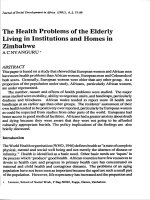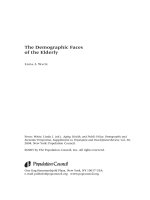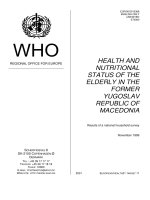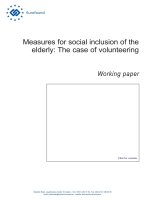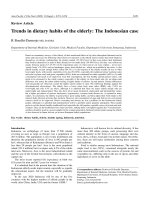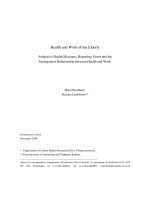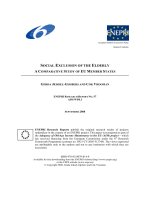Medical Information Seeking Behavior of the Elderly & Pathfinder pptx
Bạn đang xem bản rút gọn của tài liệu. Xem và tải ngay bản đầy đủ của tài liệu tại đây (39.81 KB, 9 trang )
Monique Escamilla
Medical Information Seeking Behavior of the Elderly & Pathfinder
3/10/06
I have chosen the elderly population as my group to research regarding information seeking behavior.
I will concentrate primarily on English-speaking adults age 65 and up and how they seek information
regarding their health. In terms of medical information seeking, seniors rely on direct communication
with their physicians as their primary knowledge base. For their general information needs, they tend to
seek out print sources as their primary reference.
Wicks (2004) performed an exhaustive literature review of research on the information seeking
behavior of seniors. He reports that seniors rely on interpersonal sources together with internally-
produced print materials for their information needs regarding participation in community clubs and
organizations. Seniors sought printed resources for hobby-related information seeking. For answers to
medical and financial questions, they tended to look primarily to interpersonal sources. Interpersonal
sources include physicians and pharmacists, other professionals, family members and friends. In another
study, elderly adults were willing to use the Internet as a starting point for general health information, but
when it came to making informed decisions about their health care, the majority adhered to a physician-
centered care model (Campbell and Nolfi 2005, n.p.).
Two interesting characteristics regarding this group and the way they seek information hold
significant ramifications for the overall health of seniors. Firstly, seniors tend to turn to their doctors as
their primary source of medical information. Secondly, they have, in general, resisted turning to the
Internet for their primary medical information seeking needs. These two characteristics are significant due
to changing trends in medicine. With HMO’s and hospitals demanding that doctors see a certain number
of patients each day, the average amount of time a doctor spends with her patient is fifteen minutes
(Belzer 1999, n.p.). Fifteen minutes may not provide enough time for seniors to garner the information
necessary to make critical decisions about their health. In addition, the United States is quickly moving
towards an electronic patient record and a national infrastructure that supports telemedicine and e-health.
A greater digital divide may develop between younger and older Americans that could jeopardize the kind
of medical care that seniors are receiving.
Gladden (2000) conducted a study to determine how rural older adults and their families gathered
health information to make medical decisions during times of transition. Transition was described as
facing a medical crisis which led to admission into and discharge from sub-acute care settings. Many of
the elderly interviewed expressed “being the object of decision-making and feeling marginalized and
peripheral” (Gladden 2000, 215). Gladden’s study found that the elderly population looked to direct
communication from their physicians (not nurses, nurse practitioners, or physician assistants). When these
patients did not receive visits from their doctors, they expressed feeling isolated and alienated even when
other types of health care workers visited them. In addition seniors expressed feeling that decisions were
being made for them, and that they were not provided with enough information regarding their health.
It seems apparent that new medical information resources are needed for this population group if they
are to make informed decisions about their health. Studies indicate that patients who ask questions,
discuss treatment options, express opinions, and state preferences during physician office visits have
demonstrably better health outcomes than those who do not (Campbell and Nolfi 2005, n.p.) It is
important to question how elderly patients can make the little time they have with their doctor count.
Complicating the results of other studies that indicate the elderly prefer communication with their
doctors to gather medical information, the Gladden study reveals that communication between patients
and doctors was often problematic. Patients interviewed in sub-acute settings were often scared of
appearing “nosy” when asking for information. They often put their “best foot forward” for physicians,
reporting to be doing better than they were in order to go home (Gladden 2000, 216). This hesitancy on
the part of patients to seek the information needed may have resulted from feeling helpless due to
hospitalization. How can seniors feel more proactive about their health care and less like victims?
The Internet may not be able to help the elderly when they are already hospitalized, but it could be a
useful resource to help them before they enter the hospital. The library could provide a significant “safe
place” to find information about their health—a place where they could access traditional reference
sources (books, articles, and reference librarians) in addition to the Internet where they would not feel
judged, isolated, or un-empowered. Furthermore, Campbell & Nolfi (2005) maintain that exposing
seniors to Internet-based practice guidelines and standards of care should increase the probability that
they will receive the proper treatment and take preventative measures. Although the discrepancy in
Internet use among age groups decreases each year, a large gap exists between seniors who frequently use
the Internet to find health care information and those who do not. Campbell & Nolfi (2005) state that this
gap is concerning because the shift toward managed health care exerts a larger burden on patients to make
decisions about their own health care. In addition, U.S. government agencies are now placing an
increasing amount of information applicable to Medicare and other programs on the Internet.
The Internet’s capability to revolutionize health care delivery has been highly publicized (Campbell
and Nolfi 2005, n.p.). It is essential that the elderly become adept at using the Internet for health care
purposes, especially as we move towards and electronic patient record and a national infrastructure that
supports telemedicine. The Internet contains a rich source of health-related resources for this particular
population, but there are many questions that arise in regards to older American and Internet use. Do the
elderly use the Internet? If they do, where do they use it? How can information literacy help the elderly to
learn to use the Internet?
Overall, adults age 65 and over do not appear to be using the Internet. This population has resisted
going online, but all age groups have begun to gain ground as users. (Laurich 2002, 176). Laurich
maintains that the elderly believe the Internet does not contain information highly relevant to their needs.
Moreover, more than any other age group, they tend not to have Internet access either in their home or at
work, though they do use the Internet at libraries. 22% of adults 65 and older have access to the Internet.
Of the 22% of the US adults aged 65 and over using the Internet, it is estimated that 66% use the Internet
to locate health information. Initial research suggests that highly educated white females with high
economic standing made up the majority of these information seekers (Campbell and Nolfi 2005, n.p.).
The National Telecommunications & Information Administration (2002, n.p.) has reported that
Americans 65 and older rarely perform the following Internet-based activities: visiting chat rooms,
playing games, visiting job sites, listening to music, trading stocks, or participating in listservs.
Wicks (2004) found that reading was one of the most popular past-times of the elderly interviewed in
his study. The majority of them used the library to rent books, audio, videos and participate in library
programs. If the elderly comprise a large part of the library-going population, then the library could be the
best source for medical information and information literacy training. “Library staff and administrators
should position the library as a primary access point to information on retirement planning, health issues,
second career opportunities, etc. to aid caregivers, family members, professionals, and older adults
themselves” (ALA 1999, 27).
In general, libraries play an important role in how the elderly seek information. Information literacy
efforts on the part of public libraries may help the elderly to learn to become more comfortable with the
Internet. If they come to view the Internet as an information-seeking tool, they may become more
proactive in their medical decision-making. It remains to be seen how libraries will play a future role in
teaching information literacy to the elderly so they can make the most of Internet health resources.
To accommodate the manner in which seniors currently seek information, my pathfinder focuses
primarily on printed resources that act as guidebooks that may offer some of the general health
information physicians could offer during an office visit. My pathfinder also offers resources that connect
seniors to people they can contact directly. Serious consideration must be given to help seniors become
more comfortable with the Internet in order for them to remain proactive participants in the care of their
health.
I have included web sites that are relatively easy to navigate, offer large print, and match the
Information Seeking Behavior needs of older Americans. For example, Senior Health offers the option of
asking questions of a registered nurse.
References:
ALA. “Library services to older adults guidelines.” Reference & User Services
Quarterly 39 (Fall 1999): 25-7.
Belzer, Ellen. “Improving Patient Communication in No Time.” American Academy of
Family Physicians, May 1999,
(accessed 8 March, 2006).
Campbell, Robert, and Nolfi, David. 2005. “Teaching adults to use the Internet to access health
care information: before-after study.” Journal of Medical Internet Resources 13 (Apr-Jun
2005): [n.p.]
(accessed 10 March 2006).
Gladden, Joanne. “Information exchange: critical connections to older adult decision-
making during health care transitions.” Geriatric Nursing 21, no. 4 (2000): 213-218.
Laurich, Rich. “The platinum web: sites dedicated to senior citizens on the Internet.”
Collection Building 21, no. 4 (2002):174-182.
National Telecommunications and Information Administration (NTIA). “A Nation
Online: How Americans are Expanding Their Use of the Internet.” Washington, DC:
U.S. Department of Commerce, June 3, 2005
(accessed 8
March 2006).
Wicks, Don A. “Older Adults and their information seeking.” Behavioral and Social
Sciences Librarian 22, no. 2(2004):1-26.
Pathfinder
Huffman, Robert, and John Krol, ed. Newsletters in Print, 6
th
edition. Detroit: Gale Research,
Inc, 1990.
This is a guide to newsletters published in the US and Canada. It includes a broad range of publications—
both newsletters and publications that are only loosely considered to be newsletters. These encompass
bulletins, digests, some journals, updates, and other serials that are national or regional. This guide
highlights printed and electronic newsletters and covers such subjects as medicine and medical care.
Freed, Melvyn and Karen Graves. The Patient's Desk Reference: Where to Find Answers to
Medical Questions. New York: Macmillan Publishing Company, 1994.
This book gives detailed information on where to go to find health information in printed sources
regarding the following categories: aging and the aged, dental health, the disabled, drugs use and abuse,
food facts, health and matters of law, health care centers and services, health care professionals, health
information source listings, mental health, physical fitness and sports, rehabilitation, surgery. There is
also a chapter on "Where should I go to find information in the U.S. Dept. of Health and Human
Services" which may be helpful in terms of Medicare.
AARP. AARP Bulletin. Washington, DC: Amer. Assoc. of Retired Persons.
(Published monthly except in August).
This bulletin reports on events and issues of interest to persons aged fifty and older. These events and
issues include legislative affairs that impact senior citizens, medical research, Medicare, Medicaid,
pension benefits, social security, housing, and other issues pertaining to the welfare of older Americans.
Directory of Medical Specialists. 25th Edition. 3 volumes. Wilmette:
Marquis Who's Who, Macmillan Directory Division, 1991.
(Published annually).
This is a directory of certified medical specialists arranged by specialty and geographic location. It
provides a biographical profile of each doctor, including certifications, type of practice, education,
postgraduate training, career history, address, telephone number, and other related
information. All of those listed have been certified by one or more of the American Board of Medical
Specialties.
Solutions for Better Aging. Madison: AgeNet, 2004.
(accessed March 5,
2006).
This is a helpful and general site for older people to familiarize themselves with the Internet. AgeNet’s
website has a motto: “Solutions for Better Aging.” The topics offered by the site are organized into the
following categories: Health, Drugs, Legal, Insurance, Financial, Caregiver, Housing, and Shopping.
This site contains informative articles, databases that search Caregiver Tools, Ask the Experts, &
Eldercare Locator. The site also offers Eldercare Updates, an email newsletter and an (888) phone
number to speak with an AgeNet health specialist.
Health and Age. London: Health and Age Foundation, 2006.
(accessed March 3, 2006).
This site offers seniors updated news and articles on health issues, a Primer on Aging, The Longevity
Dialogues hosted by Dr. Dean Schneider, a Questions and Answers section, and an email newsletter. The
site is attractive, well-designed, and easy to navigate. Two outstanding site features are: My
HealthandAge, which allows the user to customize the site to meet their needs, and a box that allows users
to choose the font size of the site (normal, large, and extra large options).
Creagan, Edward T. (ed.). Mayo Clinic on Healthy Aging. Rochester:
Mayo Clinic, 2001.
This guide gives succinct instructions on how to make healthy lifestyle changes, exercises,
care of the body, coping with depression and problems with memory, the importance of spirituality, when
and how to seek quality health care, and developing healthy relationships. This book is highly readable,
positive, and practical.
Gordon, Michael. Old Enough to Feel Better: A Medical Guide for Seniors. Radnor: Chilton
Book Co, 1981.
This is a friendly guide to aging which covers its social, medical, & psychological dimensions. It is
written as a ready-reference for the senior citizen which includes informative and sensitive discussions of
how to explain your medical symptoms to your doctor, how to select a surgeon, psychological aspects of
aging, nutrition for the aged, and an explanation of medical diagnostic
tests that are often performed on older people. An especially valuable section discusses a variety of health
complaints, diseases and disorders that afflict senior citizens.
Fries, James F. Living Well: Taking Care of Your Health in Middle Age.
and Later Years, 3rd edition; large print edition. Cambridge: Perseus,
2001.
This is an updated, large-print edition of a previously well-reviewed book. The author is a physician at
Stanford and well-known author who offers a thoughtful strategy for staying in good physical and mental
health. Part 1 covers vitality and aging. Part 2 outlines a strategy for staying well and Part 3 deals with
solutions and describes the 45 common problems such as low back pain, pain in the knee and skin, and
common digestive and urinary problems. Fries supplies disease charts in each instance for elementary
triage.
Maurer, Janet. How to Talk to Your Doctor: The Questions to Ask. New
York: Simon & Schuster, 1986.
Within this book’s pages are basic questions that patients should ask their doctors. This is the patient's
guidebook to inquiries she should ask concerning specific illnesses, the patient's rights and
responsibilities, the physician's rights and responsibilities, diagnostic tests & procedures, seeking a second
opinion, the role of the specialist consultant, changing doctors, hospitalization, and coping with chronic
illness.
About.com. “Healthy Aging Senior Health”. New York: The New York Times, Co,
(accessed March 5, 2006).
The interface on this site is not as elaborate as some other sites, but the subject links are highly
informative and cover a broad range of senior health topics. There is a Senior Health Essentials section
that offers a Senior Health Online Dictionary, Senior Health FAQ, Diagnostic Test Index, and Drug
Information. The most outstanding feature is the ability to ask questions of a registered nurse via the
Answers to Frequently Asked Questions sections.
Bloom, Jill. HMOs: What They Are, How They Work, and Which One is Best for You. Tucson:
The Body Press. 1987
This is a guide to the HMO industry. It explains the different types of HMOs, provides tips on how to
select the proper one based on an individual’s needs, and contains a national directory of HMO
organizations. This is written as a consumer guide.
Medi-Cal Policy Institute. Understanding Medi-Cal: the Basics. 2
nd
Edition. Oakland: Medi-Cal
Policy Institute, 2001.
Medi-Cal provides vital health and long-term care coverage to 6.5 million low-income children, their
parents, elderly, and disabled Californians. This basic guide discusses such issues as: what Medi-Cal is,
who is eligible, and how it is administered. This primer also offers a glossary and an online resource list.
Aronson, Murial, ed. Understanding Alzheimer's Disease: What it is; How to Cope With
It;Future directions. New York: Scribner's, 1988.
This book addresses the following questions: What is this disease? What are its symptoms? How is it
diagnosed? What are the treatment strategies? It also discusses long-term care options,
services for Alzheimer’s patients and their families, support groups and how and when to place a family
member in a care facility. It also covers financial and legal matters concerning patients with this disease.
